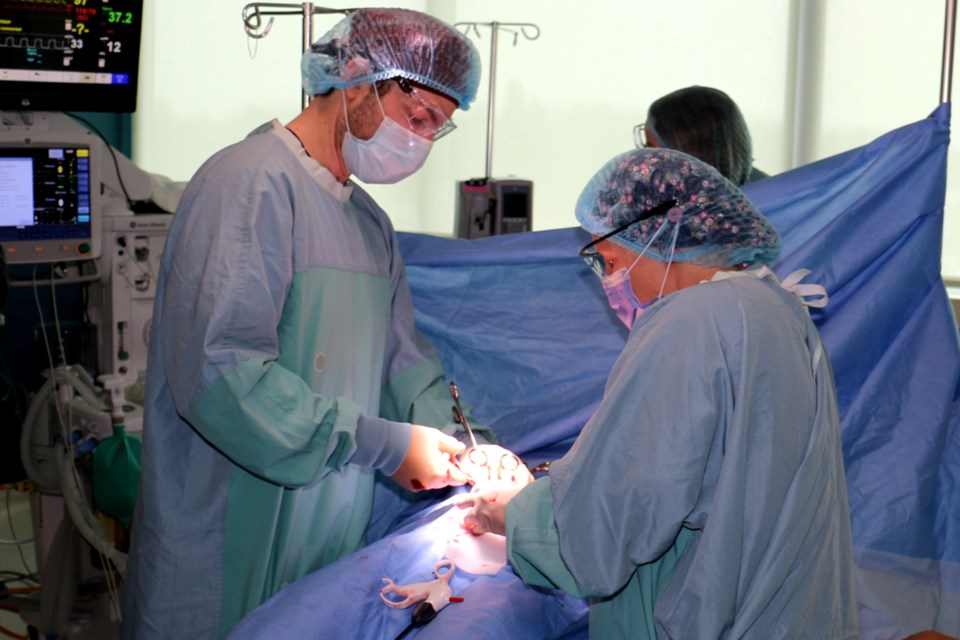If a medical student ever wondered whether she or he would be able to perform their duties at the first sight of blood, they might want to check out one of the simulation labs at the Labelle Innovation and Learning Centre at Health Sciences North (HSN).
The official opening of the new $27-million facility was just last week, but already medical learners are booked in day and night to look after a variety of sick and injured patients in a way that doctors and nurses from back in the day could only dream about.
Their patients are not real. In the "sim labs" the patients are life-like robotic figures of men, women and children that can moan, scream, cry out in pain and display a host of other symptoms such as shortness of breath and loss of blood pressure. They will even come back to life again if they're given CPR at the right moment.
The sim labs are just one part of the big picture at the learning centre where the students learn how to respond to simulated emergencies and medical problems that happen in real life. HSN recently invited Sudbury reporters along to witness a day-in-the-life of medical students at work.
In one lab, two students were performing abdominal surgery on a simulated patient, an animated mannequin.
Some problems arose with the patient thanks to a control room behind a mirror next to the operating room. That's where a technician, using wireless technology, was able to induce bleeding and change the vital signs of the patient as the surgery was in progress.
It was all very real, right down to the blood-soaked gauze bandages discarded on the floor. It was not real blood, just a synthetic red fluid that added to the realism.
Down the hall, another technician was at work creating a tiny pump that could be inserted into one of the simulated patients to better simulate where a patient was bleeding profusely.
In another simulation, an emergency room trauma team was working on a patient whose arm was amputated in a snowmobile crash. The patient was moaning loudly and trying to move while the doctors and nurses tended to his injuries.
In another lab, students can practice laparoscopic surgery using a virtual reality set-up complete with the 3D goggles that show you the inside of the human body as the surgeon explores with the laparoscopic instruments.
The learning centre is more than fancy robotics and animations.
It is also a place where students can spend time studying and working with other health-care professionals in real-life hands-on training.
Dr. Emma Pillsworth is a second-year resident at HSN. She said the new facility is a place where doctors on residency training can do their work, and their studying, and even catch a much-needed nap, all in one venue.
On the day of the media tour she was in between call-outs and was studying in a call-out room.
"Yeah, it's lovely to have this new facility with kind of everything in one spot for us. And you know, we're often on long calls, as doctors. We'll be working overnight and do a 24-hour call. So having somewhere that we can come and decompress and sleep when things are stressful," she said.
The residency doctors have access to rooms that are plain and functional, but work something like a hotel room. There's a single bed, a desk and a computer, and a bathroom with a shower. Not far from the call out rooms is a student lounge. Pillsworth said it is a place where other students and medical residents can go and consult with each other, make a pot of tea and have a snack.
"And yeah, beautiful facility. So we really appreciate it."
Dr. Aruba Nurallah, a general surgery resident, was also on call. She said the new learning centre will go a long way to helping doctors and students.
"So we do a lot of 24-hour shifts. So that's great to have a space we can come use. And it's quieter. So you're not in the main area of the hospital. So you can definitely get some rest," she said.
Narullah added that the lounge area is a place where one can decompress and discuss procedures and other things they have learned.
Dr. Greg Ross, vice-president of academic and research impact, at HSN said the new centre puts the hospital and the Northern Ontario Medical School front and centre in terms of having one of the best learning and medical innovation facilities in Canada.
Ross said there have been some health human resources challenges at HSN in recent years and it is important to provide the best possible facilities for medical professionals.
"We really have to keep our game at 100 per cent when it comes to training," said Ross.
Hospital CEO and President Dominic Giroux said the new learning centre is vital for HSN as a teaching hospital.
"This makes HSN even more of a go-to destination for learning," Giroux said.
"The opening of the Labelle Innovation and Learning Centre is definitely part of our plan to strengthen our academic and research impact for Northeastern Ontario. We know that all healthcare organizations will need to recruit top talent in the coming years," Giroux said.
He added that HSN hosts more than 2,000 students every year who come from a variety of post-secondary medical programs, whether they're student doctors, student nurses or student paramedics. Giroux said having the learning centre will make a big difference even for something as simple as debriefing nursing students in a proper setting instead of trying to crowd them into the hospital cafeteria.
Len Gillis is a Local Journalism Initiative reporter at Sudbury.com, covering health care. The Local Journalism Initiative is made possible with funding from the federal government.
